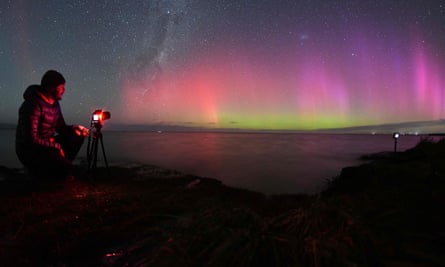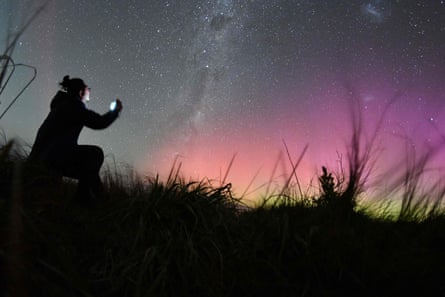New Zealand has witnessed a “solar tsunami” of activity in space that delighted Aurora hunters around the country, as the southern lights appeared in cities that would not usually get to enjoy them.
On Monday night, light-chasers took to social media to share images of purple, orange and green light washing over the hills of Christchurch, Wellington and Auckland. The unusually high levels of solar storm activity meant the Aurora Australis could be viewed far farther north than the lights are typically seen, and in cities where light pollution would normally render them invisible.

The “solar tsunami” that prompted auroras in the night sky had reached levels not seen in New Zealand since around 2017, said Devlin Lynden, project manager of University of Otago’s Solar Tsunami project, which documents solar storms and activity to model their potential effects on New Zealand’s energy infrastructure.
The Solar Tsunami project measures changing “nanoteslas” – a unit of shift in the magnetic field. While baseline movement might sit at about 20 nanoteslas, Lynden said that on Monday night they measured changes “in the regime of about 600 nanoteslas, which is as large as we’ve seen it since September 2017”.

Those same solar conditions have triggered unusual auroras in the northern hemisphere on Sunday night – with the aurora borealis documented across Ireland, parts of the UK, and in up to 30 US states.
In New Zealand, the streams of light delighted sightseers, many of whom had never captured the phenomenon before. “My first time seeing an aurora, ever,” one photographer, Chris Lierhiemer, said, as he documented the green lights surging over Christchurch’s port hills.

Auroras are wrought by disturbances such as solar flares or storms on the sun’s surface. The latest ones came after the sun let off an enormous burst of energy on Friday. Violent solar disturbances can push or pull at Earth’s magnetic field, yanking it out of shape, then snapping it back into place. Those shifts create waves moving through the Earth’s atmosphere, and electrons can ride those waves, colliding with one another and creating washes of light and colour in the sky.
“These kinds of events are centred at the [Earth’s] poles, so if there’s going to events at one pole, there’s definitely likely events at the other pole,” Lynden said.